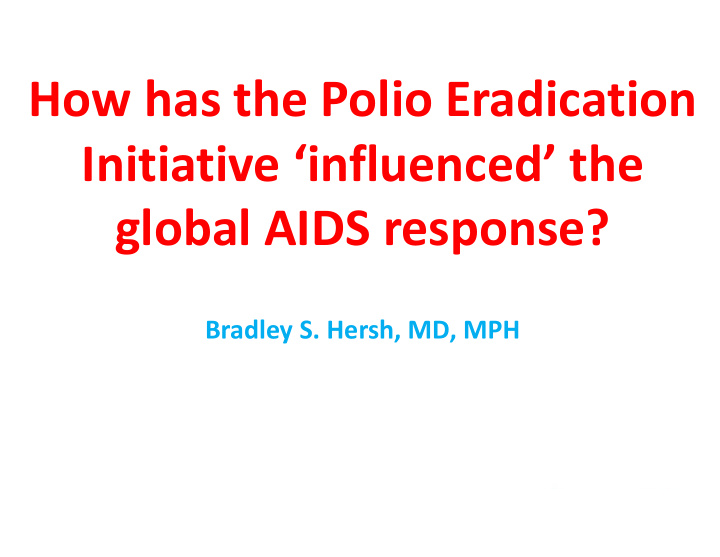



How has the Polio Eradication Initiative ‘influenced’ the global AIDS response? Bradley S. Hersh, MD, MPH
Presentation Outline • “Big history” of global HIV epidemic • Current status of HIV and the global AIDS response • Lessons learnt from PEI • Challenges for HIV ‘epidemic control’ • Moving forward
1981: First Clinical Description of AIDS MMWR 1981:30:250-252
1983: Discovery of HIV as the cause of AIDS 1983 1984
1996: Discovery of “Highly Active Anti-Retroviral Therapy” (ART) for AIDS Before ART After ART Highly active antiretroviral therapy (HAART)
2011: Emergence of HIV Treatment as Prevention Cohen NEJM 2011
2015
By 2020… 90% 90% of all people living 90% with HIV will of all people know their HIV diagnosed with of all people status HIV will receive receiving sustained antiretroviral antiretroviral therapy will have therapy. durable suppression.
International Funding for HIV/AIDS 2002-2016 $ Billion % US Source: Kaiser Family Foundation, 2017
Adults and children estimated to be living with HIV � � 2016 � � Eastern Europe Eastern Europe and central Asia and central Asia 1.6 million 1.6 million North America and western and central Europe North America and western and central Europe ������������������������� ������������������������� 2.1 million 2.1 million ������������������������� ������������������������� Middle East and North Africa Middle East and North Africa Caribbean Caribbean 230 000 230 000 310 000 310 000 ����������������� ����������������� ����������������� ����������������� Western and central Africa Western and central Africa 6.1 million 6.1 million ������������������������� ������������������������� Asia and the Pacific Asia and the Pacific 5.1 million 5.1 million ������������������������� ������������������������� Latin America Latin America Eastern and southern Africa Eastern and southern Africa 1.8 million 1.8 million ������������������������� ������������������������� 19.4 million 19.4 million ��������������������������� ��������������������������� Total: 36.7 million [30.8 million–42.9 million]
20.9 million people on treatment
CLOSING IN ON A FAST-TRACK TARGETS PROGRESS TOWARDS THE 90–90–90 TARGETS, GLOBAL, 2016 Source: UNAIDS special analysis, 2017; see annex on methods for more details
18% reduction in HIV incidence since 2000 Adults and children newly infected with HIV Range of uncertainty
33% reduction in annual AIDS-related deaths since 2000 Adult & child deaths due to AIDS Range of uncertainty
10.5% increase in Persons Living with HIV since 2000 Adults and children estimated to be living with HIV Range of uncertainty
Goal 4: Network of Public Health Reference Laboratories • Foster networks KENYA between laboratories for surveillance and ETHIOPIA early disease SENEGAL detection ETHIOPLA BENIN NIGERIA TANZANIA • Improve assessment of new products and KENYA regulatory SOUTH AFRICA TANZANIA harmonization SENEGAL • Build a south-south training programmes NIGERIA SOUTH • Establish an AFRICA international network for proficiency testing
What HIV has learned from Polio 1. Careful surveillance is key 2. Goals determine strategies 3. Coverage x Effectiveness = Impact 4. Laboratory plays central role 5. Campaigns complement routine services 6. Community mobilization & service delivery 7. The challenge of sustainability
Challenges for HIV epidemic control � HIV incidence > HIV mortality = growing epidemic � Weak health and laboratory infrastructure in high burden countries � Key Populations � Competing health priorities (e.g., Ebola, diabetes, cancer) � Long-term financing?? � Assuring lifelong treatment to all PLHIV? Adherence? � No vaccine or cure in short-term � Ongoing stigma, discrimination & marginalization � Gender inequality and assuring respect for human rights
Moving forward � Incredible progress since 1981; identified agent, diagnostic tools developed and effective prevention and treatment strategies available � Although very different viruses & diseases, the Polio Eradication Initiative has greatly influenced the global AIDS response � Community engagement is key � ART very effective in preventing AIDS-related deaths and reducing HIV transmission, but no “magic bullet” to end the global AIDS epidemic � Sustainability is a combination of country ownership, capacity development and financing. Need to develop and sustain national & regional institutions � Whether the global community can end the global AIDS epidemic by 2030 remains an open question……
Recommend
More recommend